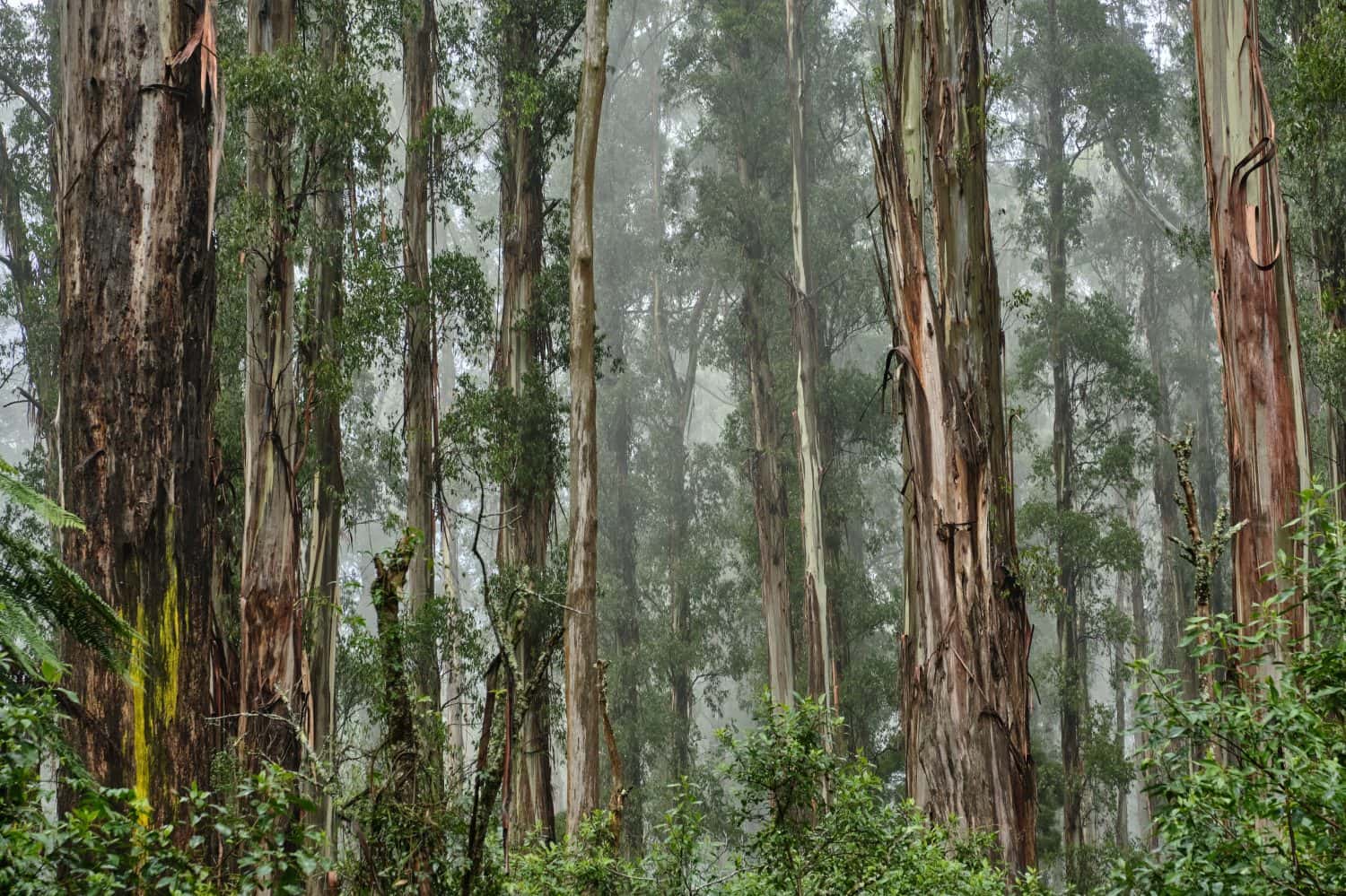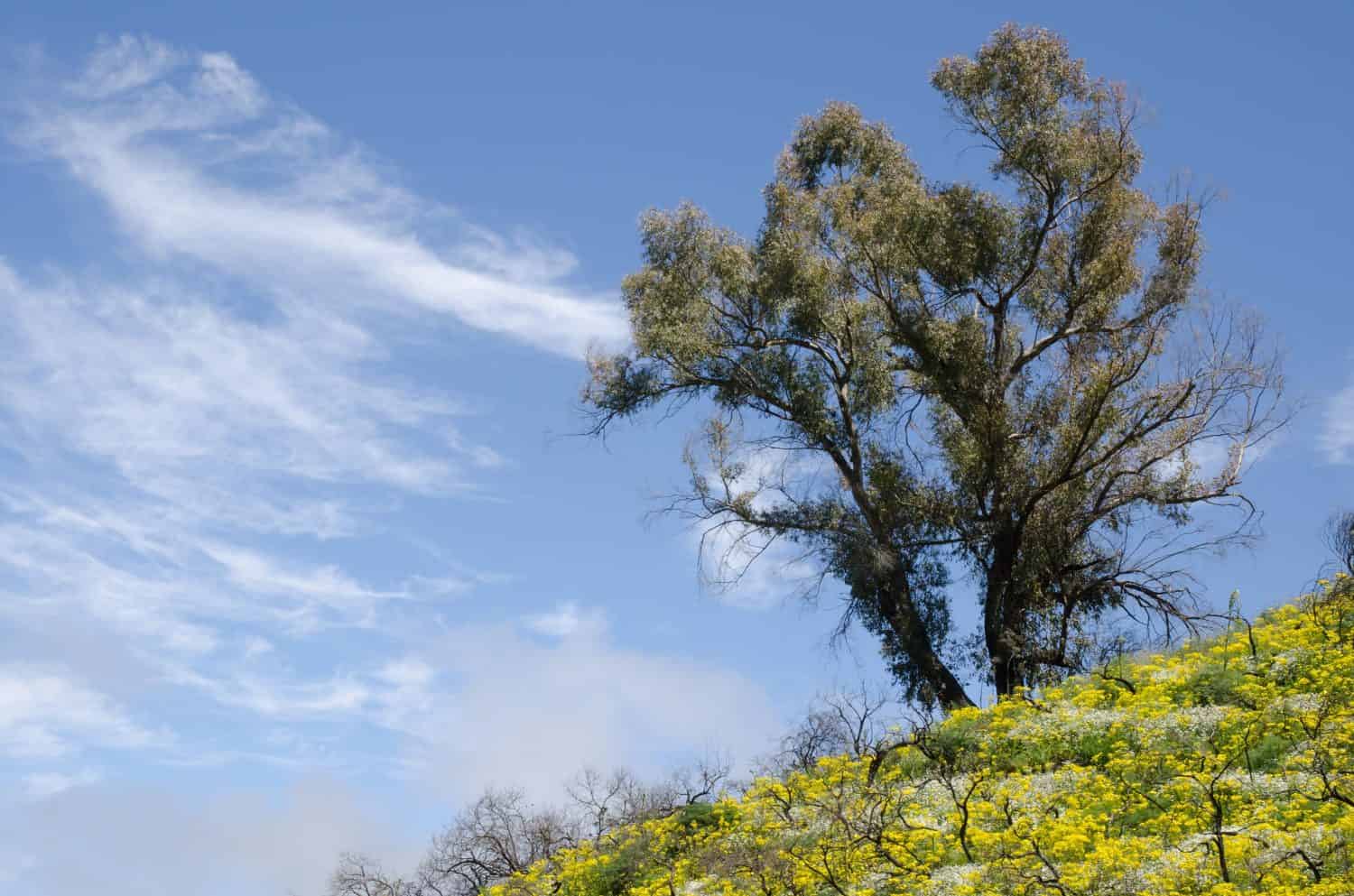The mountain ash and the southern blue gum are both trees in the Eucalyptus genus. Both of these towering giants are native to Australia, but there are differences between them. Here are a few.

The Mountain Ash

You can see the rough bark peeling at the base of this mountain ash and the smooth gray bark above it.
©Graham Drew Photography/Shutterstock.com
This towering giant is found in wet, temperate forests in the states of Victoria and Tasmania. Its trunk is straight and mostly enclosed in a smooth gray bark. However, the bark at the bottom of the tree is rough and brown. The tree grows between 230 to 374 feet tall, can have a diameter of over 8 feet, and has a small but open crown. As of 2023, the tallest is Centurion, a Tasmanian tree that’s 330 feet tall. Mountain ash trees are probably the tallest angiosperms on earth. The tree is also long-lived, and some live to be 500 years old. As they grow, they become surrounded by smaller rainforest trees, tree ferns, logs, air plants, and moss. The large trunks develop hollows and peeling bark.
The mountain ash is logged, and you can find it on plantations around the world. Its lumber is sold as Tasmanian oak, even though it’s not an oak tree. The mountain ash isn’t even an ash tree, and its scientific name is Eucalyptus regnans. It’s called an ash because its wood resembles that of the true ash in the Fraxinus genus.
The Importance of Fire for a Towering Giant
Unlike other types of eucalyptus trees, the mountain ash lacks a lignotuber. This is a swelling where the trunk meets the root that protects the plant against damage from fire and other threats. Because of this, the mountain ash is subject to destruction by the types of wildfires that have afflicted the country over the past few years. This is actually beneficial. The fire that kills a parent tree helps release its seeds, which need lots of light to germinate. Since fire removes the trees, sunlight can reach the seeds. The seeds also benefit from the nutrients in the ashes.
The mountain ash is an evergreen tree though its leaves are broad. They’re green and glossy on both sides, lanceolate, between 2.2 and 4.7 inches long, and a little less than an inch to a little less than 2 inches wide. They are full of minuscule oil glands and are arranged alternately on the stems. The white flowers appear in March and May. Later, small, hard capsules that hold pyramid-shaped seeds appear. The mountain ash is a fast-growing tree that can grow between 3 feet 3 inches to over 6 feet 7 inches a year.
A Home for Wildlife
Animals that live in and near forests of mountain ash include possums, which nest in the hollows of older trees, cockatoos, gliders, and wedge-tailed eagles. Koalas, which only eat eucalyptus leaves, eat the leaves of the mountain ash. Scientists also discovered that forests of mountain ash are unsurpassed when it comes to carbon storage, especially old-growth forests.
The Southern Blue Gum

The southern blue gum thrives in a variety of habitats. This towering giant is growing in the Canary Islands.
©Victor Suarez Naranjo/Shutterstock.com
Though Eucalyptus globulus has been known to grow over 300 feet tall, it usually only grows to 148 feet or so. It’s even found as a shrub. Some naturalists believe that these trees could even attain 400 feet, but the tallest of these towering giants were cut down. The southern blue gum is native to the Australian states of Tasmania, Victoria, and New South Wales. However, southern blue gums are found in New Zealand, California, Portugal, Spain, and Macaronesia, a collection of islands in the Atlantic owned by Portugal, Spain, and Cape Verde.
Description and Subspecies
Like the mountain ash, the bark of the southern blue gum is mostly smooth save some rough bark around the base. It’s cream or white, and unlike the mountain ash, the southern blue gum has a lignotuber. Both sides of the tree’s adult leaves are green and glossy, sickle-shaped or lanceolate, and between 5.9 and nearly a foot long. The undersides of young leaves are white. Acorn-like flower buds either sprout directly on the tree limb or from stalks. When the white blossoms appear depends on the subspecies and where the tree grows. Eventually, the flowers turn into conical or half-round capsules. This fruit gives the tree its species name of globulus. There are four subspecies of southern blue gum. They are:
- E. globulus bicostata
- E. globulus globulus
- E. globulus maidenii
- E. globulus pseudoglobulus
The southern blue gum is also like the mountain ash in that it’s grown on plantations. Plantation owners appreciate its rapid growth and its ability to thrive in different habitats. These habitats range from mountains to coastal areas and tablelands. Though the tree’s lumber is considered poor, it’s still used for pulpwood and building material and to make fence posts and poles. The leaves are used to make essential oils, and people use the leaves of E. globulus globulus to make herbal tea.
At a Glance
| Tree | Height | Habitat | Lignotuber | Bloom Time | Subspecies |
|---|---|---|---|---|---|
| Mountain Ash | 230 to 374 feet | Cool, wet forest | No | March, May | No |
| Southern Blue Gum | Usually to 148 feet or even shrubby | Variable | Yes | Depends on subspecies | Four |
The photo featured at the top of this post is © Graham Drew Photography/Shutterstock.com
Thank you for reading! Have some feedback for us? Contact the AZ Animals editorial team.







